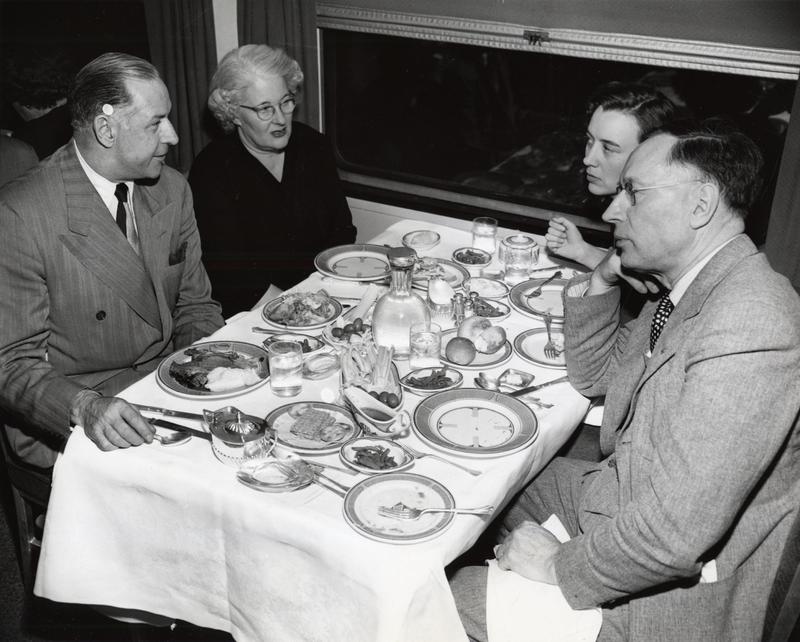The Crisler Years
In 1941, Ralph Aigler was succeeded by Athletic Director H.O. “Fritz” Crisler as the chair of the Board in Control of Intercollegiate Athletics.
Intercollegiate sports continued to operate through World War II. Athletes and coaches were seen as critical to the war effort. In 1944, Crisler stated, “Only the few who participated in football and other contact sports were equipped for physical violence.”[1]
After World War II, athletic ticket revenues increased greatly. But the majority of Michigan sports still made no profit and the football program continued to fund other athletics almost entirely. Crisler reflected on U-M’s athletic finances, “The Board has only two sources of income for carrying on… football gate receipts and, second, the portion of student tuition fees allocated by the Board or Regents.”[2] By the middle of the decade football profits exceeded $600,000 per year.
Crisler’s time as chair of the Board in Control saw the relaxation of regulations on U-M athletics. Beginning in the 1920s, the Big Ten had banned post-season football games. But in 1946, U-M voted to resume operation of the Rose Bowl game, and this vote received Big Ten approval.
More money flowed into Michigan athletics during the 1950s, and more regulations were struck down. By the middle of the decade, football made over $875,000 per year and U-M began televising its football games. At first, Crisler was hesitant to allow TV broadcasting, as he noted that television was driving down athletic admissions at other colleges, as well as admissions in professional sports.[3] However, Crisler’s doubts vanished as television revenues grew swiftly;, by the end of the decade, U-M pocketed over $90,000 per year from television rights.
In 1955, after 40 years on the Board in Control of Intercollegiate Athletics, Ralph Aigler left the Board. His departure had a significant impact on the organization and on athletic policy at U-M. Aigler had been strongly opposed to athletic scholarships, believing that they were immoral and antithetical to amateurism.[4] During his tenure, the Big Ten Conference did not allow colleges to consider athletic ability when giving financial aid. Crisler did not share Aigler’s view, however, and one year after Aigler left, Crisler and the University voted to provide student financial aid based on athletic ability; the Big Ten put this rule in place in 1957.[5] U-M had complained that without the ability to provide athletic scholarships, the University was unable to compete against non-conference schools, who could provide financial assistance without Big Ten regulations. The new athletic scholarships established in the 1950s were limited to the cost of room, books, board, and tuition.Universities had to take financial need into consideration when awarding scholarships, and athletes had to meet certain academic standards. Aigler was furious with these changes. Writing for a journal in 1957, he stated, “The simple truth is that these aids set off athletes as a special class and amount to pay for play.”[6]
The initial regulations placed on athletic scholarships loosened in the sixties. By 1962, Big Ten universities could issue scholarships without taking financial aid into consideration; the academic requirements were also lowered.
The 1960s saw Basketball emerge as a significant financial boon for U-M, and it made well over $100,000 by the end of the decade. Football profits continued to skyrocket, passing the million-dollar mark in profits in the 1960s; , in 1969-1970, football grossed over $1.2 million.
[1] “Football and War”, Gould Battery News 1944, Speeches and Articles 1921-1947, Box 2, H. O. Crisler Papers, University of Michigan Bentley Historical Library, Ann Arbor, MI.
[2] 1944/45 Annual Report p.7, Annual Reports 1940/41-1949/50, Box 32, Board in Control of Intercollegiate Athletics (University of Michigan) records, University of Michigan Bentley Historical Library, Ann Arbor, MI.
[3] Michigan Business Review Vol. III No. 3 May 1951, Speeches and articles, 1950-51 and 1969, Box 2, H. O. Crisler Papers, University of Michigan Bentley Historical Library, Ann Arbor, MI.
[4] 1937/38 Annual Report, Annual Reports 1931/32-1939/40, Box 32, Board in Control of Intercollegiate Athletics (University of Michigan) records, p.11, University of Michigan Bentley Historical Library, Ann Arbor, MI.
[5] 1955/56 Annual Report, Annual Reports 1951/52-1958/59, Box 32, Board in Control of Intercollegiate Athletics (University of Michigan) records, University of Michigan Bentley Historical Library, Ann Arbor, MI.
[6] Michigan Alumnus Quarterly Review, December 7, 1957, Writings, Athletics, Box 15, Ralph W. Aigler Papers, University of Michigan Bentley Historical Library, Ann Arbor, MI.


